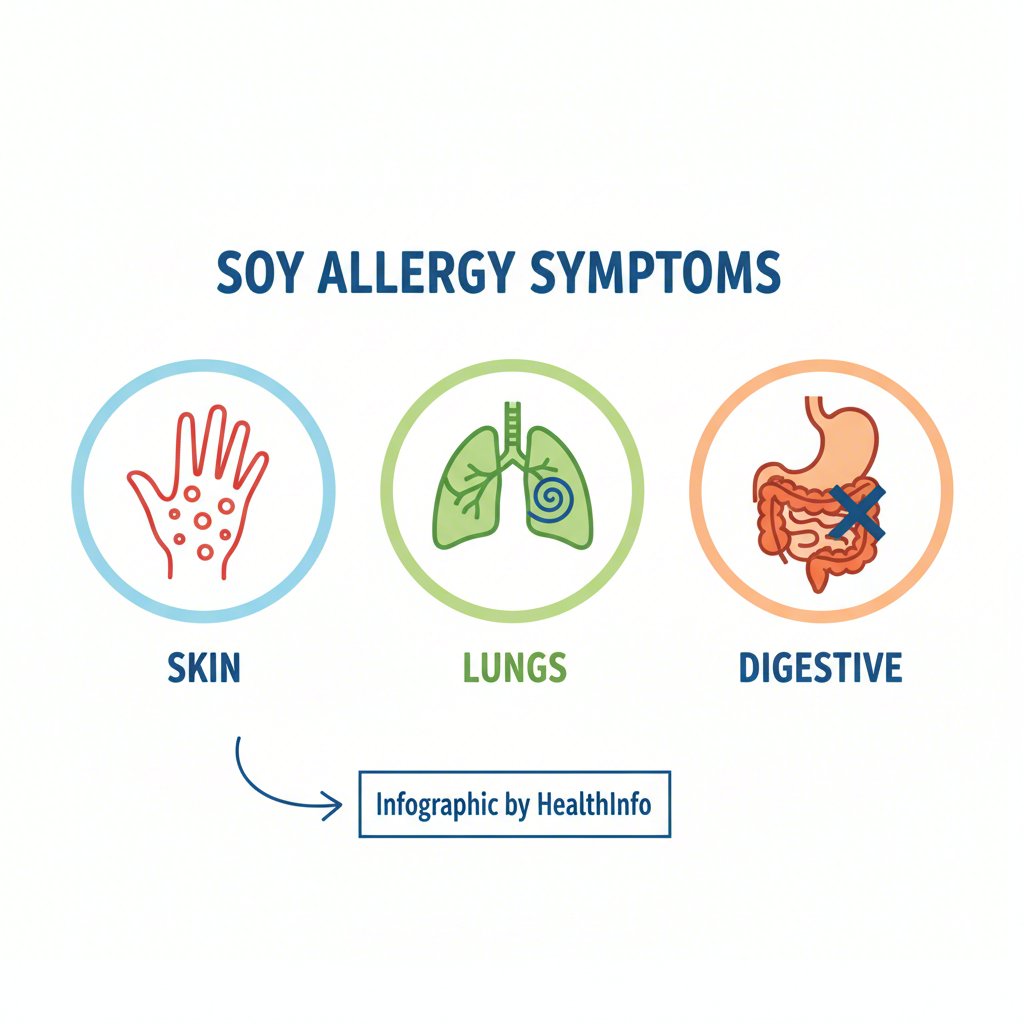TL;DR
A soy allergy is an immune system response to soy protein, triggering a range of symptoms. Common signs include skin reactions like hives and swelling, respiratory issues such as wheezing or coughing, and gastrointestinal distress like stomach cramps and diarrhea. While many reactions are mild, severe cases can lead to a life-threatening condition called anaphylaxis, which requires immediate medical attention.
The Definitive Soy Allergy Symptom Checklist
Identifying a soy allergy begins with recognizing the specific signs your body exhibits after consuming soy products. A reaction occurs when your immune system mistakenly identifies soy protein as a threat, releasing chemicals like histamine that cause symptoms. These symptoms can appear within minutes to a few hours and vary widely in presentation and severity.
To help identify a potential reaction, symptoms can be grouped by the part of the body they affect. Documenting which symptoms you experience can provide crucial information for a discussion with a healthcare professional.
Common Symptoms by Category
- Skin Reactions: The skin is one of the most common areas affected. Look for signs such as hives (red, itchy welts), eczema (a scaly, itchy rash), redness, and swelling, particularly around the mouth, lips, and face.
- Gastrointestinal Signs: The digestive system often reacts with discomfort. Symptoms include abdominal pain, stomach cramps, nausea, vomiting, and diarrhea.
- Respiratory Symptoms: A soy allergy can impact breathing. Common signs are a runny nose, sneezing, coughing, wheezing, or a feeling of tightness in the throat.
- Cardiovascular Symptoms: In more serious reactions, you might notice a rapid heartbeat, a drop in blood pressure causing lightheadedness, or pale or bluish skin.
Understanding the difference between a mild and severe reaction is critical for safety. While mild symptoms are uncomfortable, severe symptoms can be life-threatening.
| Mild Symptoms | Severe (Anaphylactic) Symptoms |
|---|---|
| A few hives or a mild rash | Widespread hives and swelling |
| Itching or tingling in the mouth | Swelling of the tongue or throat, causing trouble breathing |
| Stomach cramps or nausea | Severe vomiting or diarrhea |
| Runny nose or sneezing | Wheezing, coughing, or shortness of breath |
| Dizziness, confusion, or loss of consciousness |
If you observe any of these symptoms after consuming soy, it is essential to document them and consult an allergist or healthcare provider for proper diagnosis and guidance. Do not attempt to diagnose a food allergy on your own.
Recognizing Severe Reactions: Signs of Anaphylaxis
The most serious risk associated with a soy allergy is anaphylaxis, a severe, whole-body reaction that is a medical emergency. Anaphylaxis can occur suddenly and progress rapidly. According to leading medical sources like the Cleveland Clinic, knowing the signs is crucial for a swift response that could save a life.
Unlike milder symptoms, anaphylaxis affects multiple body systems at once. The onset of these symptoms demands immediate action. Key signs of a severe anaphylactic reaction include a sudden and severe combination of the symptoms listed in the checklist above.
Critical Signs of Anaphylaxis
Pay close attention to these danger signs:
- Difficulty Breathing: This can be caused by significant swelling of the tongue or throat, leading to a feeling of tightness or closure.
- Significant Drop in Blood Pressure: This can cause dizziness, confusion, fainting, or a weak, rapid pulse.
- Pale or Blue Skin: As noted by the American College of Allergy, Asthma & Immunology (ACAAI), a change in skin color is a sign of a severe reaction.
- Sense of Impending Doom: Many people experiencing anaphylaxis report feeling extreme anxiety or a sense that something is terribly wrong.
If you suspect someone is experiencing anaphylaxis, you must act immediately. Do not wait to see if symptoms improve on their own.
Emergency Action Steps
- Administer Epinephrine: If the person has an epinephrine auto-injector (like an EpiPen), use it immediately as prescribed.
- Call for Emergency Medical Help: Dial 911 or your local emergency number right away. State that you suspect anaphylaxis.
- Position the Person Safely: Have the person lie down flat on their back. If they are vomiting or having trouble breathing, they can be placed on their side.

Soy Allergy vs. Soy Intolerance: Understanding the Difference
It’s common for people to confuse a soy allergy with a soy intolerance, but they are fundamentally different conditions. A true soy allergy is an immune system response. An intolerance, on the other hand, is a digestive system issue where the body has difficulty breaking down soy, leading to discomfort but not a life-threatening reaction.
The symptoms of soy intolerance are generally confined to the gastrointestinal tract and may include gas, bloating, stomach pain, and diarrhea. These symptoms, while unpleasant, do not involve the immune system and do not pose the risk of anaphylaxis. For those managing an intolerance, pinpointing triggers is key. When you control your ingredients, tracking symptoms becomes much simpler. If you enjoy plant-based milks, exploring the best plant milk makers can be a great way to create fresh, additive-free options at home, ensuring you know exactly what you’re consuming.
The following table highlights the key distinctions:
| Feature | Soy Allergy | Soy Intolerance |
|---|---|---|
| System Involved | Immune System | Digestive System |
| Bodily Response | Produces IgE antibodies; releases histamine | Difficulty digesting soy components |
| Common Symptoms | Hives, swelling, wheezing, vomiting, anaphylaxis | Gas, bloating, stomach pain, diarrhea |
| Onset Time | Rapidly, from minutes to two hours | Slower, often several hours after consumption |
| Severity | Can be life-threatening | Uncomfortable but not life-threatening |
A healthcare provider can perform tests to determine whether you have an allergy or an intolerance. A correct diagnosis is essential for creating a safe and effective management plan.

Special Considerations: Soy Allergy in Babies and Children
In infants and young children, a soy allergy can present differently than it does in adults, making it challenging for parents to identify. According to pediatric health resources like Kids with Food Allergies, symptoms in babies may be more subtle and can be mistaken for other common infant issues.
For breastfed babies, a reaction can occur if the mother consumes soy, as the protein can pass through her breast milk. In formula-fed babies, a reaction to soy-based formula is a more direct indicator. Parents should be vigilant for a pattern of symptoms that appear after feeding.
Symptoms to Watch for in Infants
- Digestive Upset: This is a primary sign and can include frequent spitting up or reflux, vomiting, diarrhea, constipation, and visible blood or mucus in the stool.
- Skin Issues: Eczema, rashes, or hives are common skin manifestations in infants with a soy allergy.
- General Discomfort: Unexplained fussiness, colic-like crying for long periods, and difficulty being soothed can also be indicators.
- Poor Growth: In some cases, a food allergy can interfere with nutrient absorption, leading to poor weight gain or failure to thrive.
If you suspect your baby has a soy allergy, it is crucial to consult a pediatrician or a pediatric allergist. They may recommend an elimination diet for the breastfeeding mother or a switch to a hypoallergenic formula under strict medical supervision. Never make significant dietary changes for your baby without professional medical advice.
Frequently Asked Questions About Soy Allergy
1. Can soy cause chest pain?
Yes, in some cases, soy can be associated with a condition called eosinophilic esophagitis. This is an immunological inflammatory condition of the esophagus that can cause symptoms like chest pain and difficulty swallowing. If you experience these symptoms, it is important to seek medical evaluation to determine the cause.
